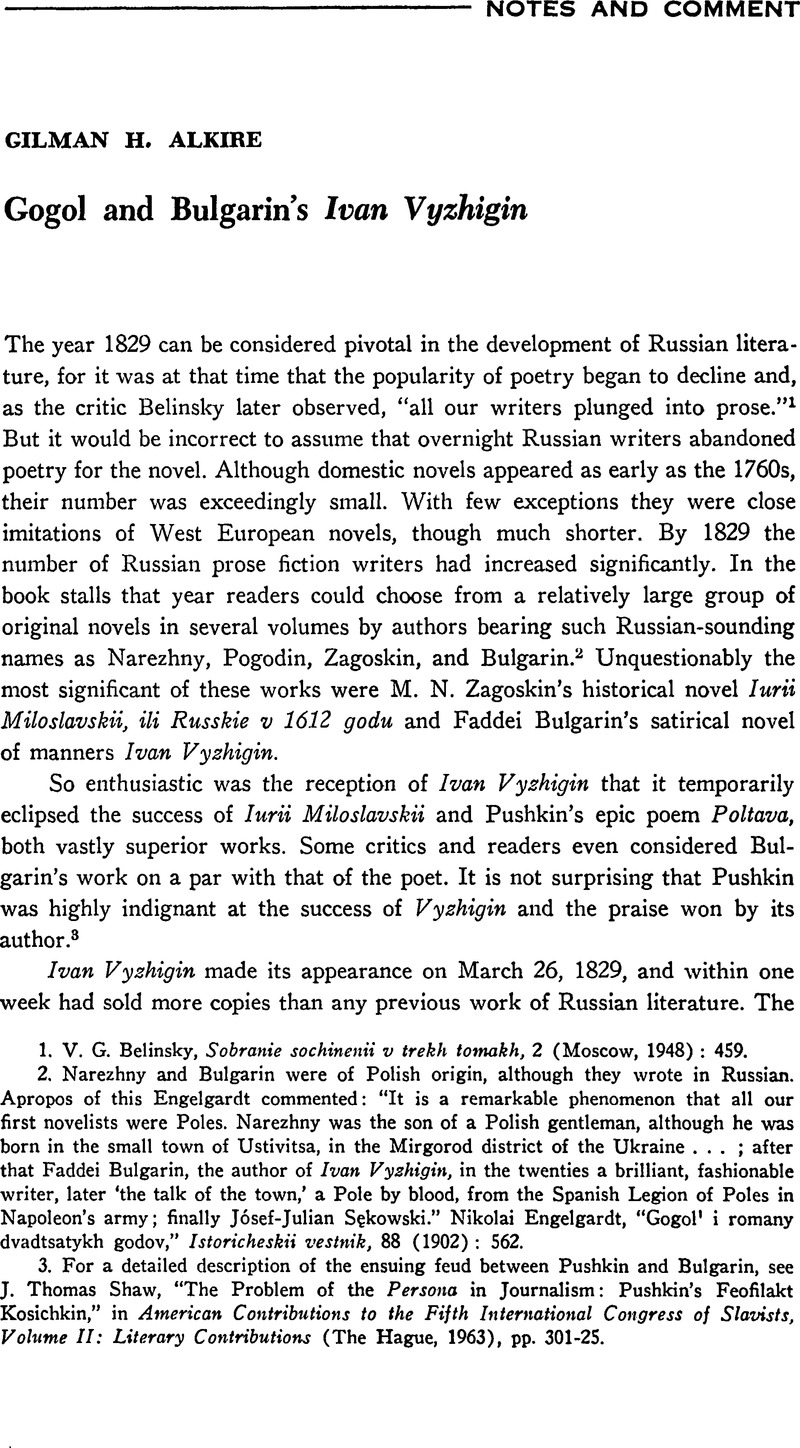No CrossRef data available.
Article contents
Gogol and Bulgarin's Ivan Vyzhigin
Published online by Cambridge University Press: 27 January 2017
Abstract

- Type
- Notes and Comment
- Information
- Copyright
- Copyright © Association for Slavic, East European, and Eurasian Studies. 1969
References
1. Belinsky, V. G., Sobranie sochinenii v trekh tomakh, 2 (Moscow, 1948): 459.Google Scholar
2. Narezhny and Bulgarin were of Polish origin, although they wrote in Russian. Apropos of this Engelgardt commented: “It is a remarkable phenomenon that all our first novelists were Poles. Narezhny was the son of a Polish gentleman, although he was born in the small town of Ustivitsa, in the Mirgorod district of the Ukraine …; after that Faddei Bulgarin, the author of Ivan Vyzhigin, in the twenties a brilliant, fashionable writer, later ‘the talk of the town, ’ a Pole by blood, from the Spanish Legion of Poles in Napoleon's army; finally Jćsef-Julian Sekowski.” Engelgardt, Nikolai, “Gogol’ i romany dvadtsatykh godov,” Istoricheskii vestnik, 88 (1902): 562.Google Scholar
3. For a detailed description of the ensuing feud between Pushkin and Bulgarin, see J. Thomas Shaw, “The Problem of the Persona in Journalism: Pushkin's Feofilakt Kosichkin,” in American Contributions to the Fifth International Congress of Slavists, Volume II: Literary Contributions (The Hague, 1963), pp. 301-25.
4. Until the 1860s Severnaia pchela was the only privately owned daily newspaper in Russia. The duties of publisher were shared by Bulgarin and N. I. Grech.
5. In Der Schelmenroman in Russland (Berlin, 1961) Jurij Striedter presents an exhaustive study of the rise and fall in popularity of the Russian rogue novel. He devotes considerable space to a discussion of Ivan Vyzhigin and its imitators.
6. Gippius, V. V., ed., N. V. Gogol': Materialy i issledovaniia, 2 vols. (Moscow and Leningrad, 1936), 1: 294.Google Scholar
7. Fokt, Iurii, ‘“Ivan Vyzhigin’ i ‘Mertvye dushi, ’ “ Russkii arkhiv, 8 (1902): 603.Google Scholar
8. Nilsson, Nils Åke, “Gogol et Péterbourg: Recherches sur les Antécédents des Contes Pétersbourgeois,” Etudes de philologie slave, 4 (Stockholm, 1954): 58.Google Scholar
9. Bulgarin, F. V., Polnoe sobranie sochinenii, 7 vols. (St. Petersburg, 1839-44), 1: 211.Google Scholar Citations from Bulgarin refer to this volume unless otherwise indicated.
10. Gogol, N. V., Sobranie sochinenii v shesti tomakh (Moscow, 1949-50), 6: 108.Google Scholar
11. Ibid., pp. 107-8. 12, Nilsson, p. 27.
13. Gogol, 4: 10.
14. Ibid., 5: 308.
15. Ibid., p. 291.
16. Striedter, p. 214.
17. Gogol, 3: 125-26.
18. Bulgarin, 4: 28-29.
19. Gogol, 3: 126.
20. Moskovskii telegraf, July 1829, no. 13, p. 79.




